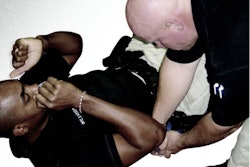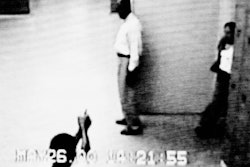Ron Redding needed a rest. The duties of a lieutenant and SWAT officer with the Gulfport (Miss.) Police Department had drained him.
And his home life, though rewarding, hadn't exactly been restful. With one child under the roof and his wife, Sandy, in her final trimester with a second, he'd been playing Mr. Mom off duty.
But now rest was coming. He and Sandy would soon be packing up themselves and the baby and heading to a rented beach house for a vacation. Redding needed the down time, and the thought of it made him smile.
What made him smile even more was that the house was finally quiet. His wife was down for a short snooze. So was baby Peyton. So Redding decided to indulge in a short nap before lunch. If everything went according to Hoyle, he'd be up and about in an hour or so with enough energy to face the rest of the day.
The Wannabe
Things did not go as planned. As soon as Redding lay down, he heard a series of sharp pops. Redding's trained ear told him immediately that the sounds cracking outside his house were gun shots.
He leapt from the bed and looked out an upstairs window in an effort to determine where the rounds were coming from…and where they were headed.
Below, a neighbor angled her head over her fence for a view of the street fronting their properties. Unable to get a bearing on the threat, Redding ran downstairs to his front door and opened it.
What he saw froze him. An agitated male was dragging a handcuffed woman down the street with his left hand while cradling an AR-15 rifle in his right. Ronnie recognized the couple. The hysterical woman was a neighbor; the black-clad male was Clinton Byrd, her estranged boyfriend.
Byrd had relatives in law enforcement and, at one time, he had even been an Explorer at Redding's station. Redding also knew that even though Byrd had never realized his dream of being an officer, he was familiar with a variety of firearms. And knew how to shoot them.
Running upstairs to his bedroom, Redding yelled for Sandy to dial 911 and to stay in the house. He threw on a pair of shorts, a T-shirt, and his duty vest. Then he grabbed his sidearm and the keys to his patrol car, which was parked in the driveway.
By the time Redding made it back outside, the man and woman were nowhere to be seen. Probably dragged her back to her house, he thought.
Redding needed his SWAT gear. His tactical vest. His AR-15. His TAP ammo. So he went to his car, popped the trunk, and found….Nothing.
Looking into that empty trunk, he realized what had happened. He'd lent the gear to a recent transfer to the tactical unit. At the time, it didn't seem like a big deal to the vacation-bound Redding. Now, his generosity loomed ominously. Of all the times…
He'd have to make do. Redding slid into the front seat of the unmarked car, fired the engine, put the car in gear, then began a slow roll in the direction of the woman's house.
Redding's house was mid-block on a cul-de-sac; the kidnapped woman's house was at the opening of that same cul-de-sac where it formed a “T”-intersection with another street. Redding pulled up three houses short of her home.
Another volley of shots rang out. The slow, deliberate fire suggested that the shooter was taking his time, carefully targeting victims that Redding could not see. The gunfire sounded like it was originating from the woman's front yard.
Bulletproof
Redding exited his car and ran to a house next to the woman's. Determined to gain a tactical advantage on the shooter, Redding entered the rear of the neighboring property and paralleled a rear fence to her back yard.
Getting a visual on the back of the woman's house, Redding hunkered down and surveyed the rear windows for any secondary threats. Finding none, he sidled up the side of the house to get a look at what was happening in the front yard.
Out front, Byrd stood erect, continuing to fire at unseen victims, his posture eerily in comport with something that Ron had seen before. It took him a second to place it: The guy was assuming the same shooting poses as the gunmen at the North Hollywood shootout. Like every cop in America, Redding had watched that video more than a dozen times, each time wondering what he would do if faced with a suspect armed with military weapons and protected by body armor.
Like the gunmen in North Hollywood, Byrd was taking his time, aligning his sights before unleashing another volley of shots. He was acting like he was bulletproof. Was he wearing armor? Redding cringed at the thought.
Redding needed to know more. But he couldn't expose himself. If the suspect saw him, it could precipitate an exchange of gunfire with the heavily armed gunman. Redding was only armed with his duty Glock and covered by his patrol vest, which would be about as good as a cotton shirt against the gunman's AR-15 and its .223 caliber rounds. He didn't like the odds.
Still, he needed some information. And he needed a shot. Redding inched forward to the corner of the house, took a quick peek around the corner, and backed off.
Byrd, camouflaged entirely in black, was standing by his truck which was parked in front of the house. He was using the truck as cover, firing volley after volley of aimed fire down the street.
Redding recalled his previous contacts with Byrd. The 22-year-old wanted to be a cop in the worst way. But here he was, dressed from head to toe in black, firing round after round into a normally quiet neighborhood and terrorizing a hostage. Someone had to stop him.
And Redding knew the job had fallen into his lap. He bent to one knee at the corner of the house. Then he angled his head away from the building just enough to get a bearing on his target.
Byrd had stopped firing and was now dragging his screaming hostage toward the front of the house. If Byrd got inside, a best case scenario would mean a barricade/stand-off. The worst: a murder/suicide.
Now or Never
Redding made his move. He slid his front leg forward, transitioned his Glock to his weak hand, steadied it against the stuccoed wall, and leveled its sights on the suspect.
The man and the girl were about 40 feet away, coming headlong toward him. Byrd looked up and appeared to see Redding. The barrel of the AR-15 swung in Redding's direction.
It was now or never. Redding squeezed the Glock's trigger.
The round caught Byrd center mass. He tumbled backward, his grip on the girl's handcuffs yanking her with him so that she swung directly into Redding's line of fire.
Redding wanted to fire again, but his training and experience caused him to freeze his finger against the trigger. The girl was in the way. He backed out of the kill zone just as the suspect let loose with a volley of shots that struck the front of the house.
Had Byrd seen him and fired? Or had the rounds he'd fired been more reflexive in nature? Finally, had the single round that he had fired at Byrd done its job?
He backed up and peered through a window on the side of the house, which availed him a view through the interior of the house and another window at the front. Byrd was lying on his back on the front lawn. The girl was nowhere to be seen.
A mere 30 feet separated Redding and the gunman. He couldn't tell if Byrd was truly down and out or playing possum. Any element of surprise Redding had was now gone, and he didn't want to challenge the gunman right away.
Redding had to place some distance between himself and the gunman. He backed off down the side of the house.
He could now see that Byrd's still handcuffed captive had somehow gotten free and was running down the street. Part of Redding wanted to back track to the neighbor's house for cover, but even though that might have been a wise move, he didn't want to risk getting nailed on the run. He decided to make a move for cover behind a tree that separated the girl's property from her neighbor's.
Despite his lack of uniformed attire, Redding was recognized by two fellow Long Beach officers who'd just arrived. The trio of officers made a cautious approach on the gunman, weapons drawn, as they converged.
Redding scooted the AR-15 away from Byrd as the other officers handcuffed the gunman. He also removed a Glock 9mm from Byrd's waistband.
The close-up view confirmed Redding's worst fear. Byrd was wearing body armor.
Redding breathed deeply, realizing how close he had come to dying. Then, looking down at Byrd, he realized that he couldn't see any blood. He looked closer. Along the clavicle line, just above the top of the vest, he saw an entry wound.
Byrd's breathing was becoming more labored. There was nothing Redding could do. So he looked up for some momentary distraction.
Officers Down
It was then that he learned who Byrd had been targeting. Across the street, through the shattered windows of an unmarked parked patrol car, he saw the bloodied lower torso of a Gulfport PD officer, Sgt. Bryan Young. Redding ran to assist him.
Rounding the front of the car, Redding came upon Gulfport PD Det. Jim Northcutt. He was on the ground.
A .223 round had severed Northcutt's femoral artery, and he was bleeding out. Despite the valiant efforts of fellow officers and EMT personnel, Northcutt died.
Up the street at the intersection, another officer was down. This officer, Sgt. Steve Morgan, had waved off medical attention to allow paramedics to get to Northcutt. He would later die at a hospital.
The officer in the car, Sgt. Young, was seriously wounded but he survived.
The enormity of the situation was coming into focus for Redding. Two officers had been killed and a third was down. And he had killed a man. Redding knew he had to do it. But he had killed a man.
Byrd's rampage began with the breakup of his relationship with the girl. Earlier that day, he'd shown up at her home, heavily armed and wearing a ballistic vest. He was intent upon killing the girl and her mother and as many others as he could before taking his own life. Now, he was dead. More importantly, so were two good cops.
Redding was hailed as a hero. In the weeks that followed, letters came in from the community, thanking Redding for his bravery. He was given many awards, including the Mississippi Medal of Valor.
In 1999, Redding was honored as Mississippi Police Officer of the Year. He also attended the National Law Enforcement Peace Officers' Memorial in Washington. Tears filled his eyes as the names of Sgt. Steve Morgan and Det. Jim Northcutt were added to the memorial.
Dean Scoville is a patrol supervisor with the Los Angeles County Sheriff's Department and a contributing editor to Police.
Shots Fired: Long Beach, Mississippi 05/06/1998
Ron Redding needed a rest. The duties of a lieutenant and SWAT officer with the Gulfport (Miss.) Police Department had drained him.












